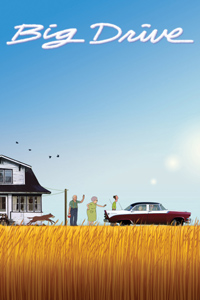| ________________
CM . . .
. Volume XX Number 21. . . .January 31, 2014 
 |
Big Drive.
Anita Lebeau (Director). Derek Mazur (Producer).
Montreal, PQ: National Film Board of Canada, 2012.
9 min., 17 sec., DVD, $34.95 (School classroom use)
Order Number: 153C9911624
Grades 2-9 / Ages 7-14.
Review by Julie Chychota.
**** /4
|
| |
|

Big Drive transports viewers on a whimsical journey back to the early 1970s. Wedged into the backseat of the family car, four sisters embark on a drive home across the Prairies from their grandparents’ house. Given the photographs that accompany the closing credits, it’s safe to surmise that the childhood experiences of writer and director Anita Lebeau fuelled this animated road trip, while original music by Dan Frechette adds momentum to the vehicle. This NFB production, with its droll portrayals and sympathy towards children’s perspectives, conjures up the spiritedness of Beverly Cleary’s “Ramona” books; Lebeau’s characters even look as though they might have descended from Louis Darling’s illustrations crossed with Alan Tiegreen’s. Nevertheless, Big Drive puts its own Canadian spin on sibling dynamics.
The narrative unfolds simply. In the initial frames of the video, four children waist-deep in a wheat field wave at an airplane in a brilliant blue sky. A horn summons them, eliciting from the oldest a resigned response of “Eight hours in the car.” The sisters, next seen sitting in the back of a Dodge, range in age anywhere from seven to sixteen and demonstrate little interest in the scenery along the highway. They become increasingly restless in the heat and close quarters, and just as quickly as a thunderstorm breaks overhead, tensions inside the vehicle erupt. Only after they reconcile are the girls able to collaborate and let their collective imagination take flight — figuratively for them and literally for viewers. In the trippy little segment that follows, viewers witness the transformation of a stuffed toy mole, a rabbit’s foot keychain-cum-rabbit, the bobble-head turtle in the car’s rear window, and a gopher into pilots of biplanes soaring over patchwork crops. The illusion ends when the girls realize with a start that they’ve arrived home. The spirit of amicability extends to the last image of the siblings in which they huddle around an upstairs window to propel a paper airplane out into the night.
Big Drive strongly evokes a particular time and place, most obviously through the car’s licence plate, which reads "Sunny Manitoba / 71.” Yet even apart from those signifiers, the animators (Lebeau and Chris Cormier) drop hints about the era through hairstyles, fashion, and automotive design. The mother’s bouffant, the father’s sideburns, the youngest daughter’s bold, colour-blocked, geometric-patterned dress, and the elaborate tailfins on the “Custom Royal Dodge” all suggest the late 1960s or early 1970s. Additionally, the fanciful flight segment calls to mind the psychedelic experiments of that time period. In terms of place, the animation reflects an appreciation for the diversity of the Manitoba countryside, capturing not only the obligatory fields, farmyards, trees, a train, a tractor, and animals domesticated and wild, but also ponds, culverts, bridges, birds, a graveyard, and even a small stretch of sand dunes (which might be a nod to the Spirit Sands in Spruce Woods Provincial Park). This richness in visual detail paired with minimal dialogue make Big Drive accessible to persons with hearing disabilities in the absence of closed captioning, but would require descriptive video service for persons who are visually impaired to make sense of the action.
This animation is fun and family-friendly, ideal for parents or grandparents to watch with children of almost any age. It might lead to informal storytelling afterwards should the different generations wish to share and compare their versions of family road trips. Aside from recreational value, however, Big Drive could be useful in educational settings, especially in English classes, to ignite ideas for creative writing or storytelling assignments. It could also be used to analyze techniques of plot development, characterization, or point of view, in courses on literature or computer animation.
At nine minutes and seventeen seconds, this joyride feels like it’s over much too soon, but Lebeau’s playful depiction of a family’s summer outing is a balmy antidote to a harsh Canadian winter. While firmly fixed in time, this warm and whimsical animation encapsulates some timeless truths about family ties.
Highly Recommended.
Julie Chychota is a transplanted Manitoban living in Ottawa, ON. She has fond recollections of a family road trip to the Maritimes the summer before she entered tenth grade.

To comment
on this title or this review, send mail to cm@umanitoba.ca.
Copyright © the Manitoba Library Association. Reproduction for personal
use is permitted only if this copyright notice is maintained. Any
other reproduction is prohibited without permission.
NEXT REVIEW |
TABLE OF CONTENTS FOR THIS ISSUE
- January 31, 2013.
AUTHORS |
TITLES |
MEDIA REVIEWS |
PROFILES |
BACK ISSUES |
SEARCH |
CMARCHIVE |
HOME |
